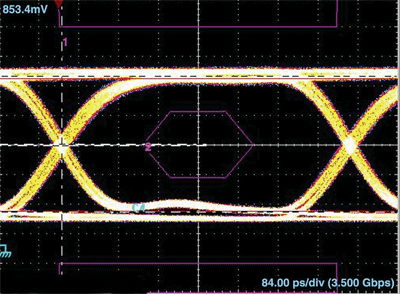Selecting a cabling solution for high-definition video
Gaming and other HD apps are pushing aggregate data rates over 10 Gbits/s, so designers are seeking cabling alternatives
BY MARTIN SMITH
Omron Electronic Components
Schaumburg, IL
http://www.components.omron.com
The prodigious throughput dictated by high-definition video is driving many designers of video systems, for applications ranging from gaming to medical and industrial telecommunications, to look at alternatives for cabling system. These HD apps are pushing aggregate data rates over 10 Gbits/s to add support deep color, True HD codecs, and other performance features videophiles demand.
Experience designers know that, no matter how thoughtfully copper methodologies are used, sending gigabit signals involves a tradeoff with distance: at these speeds, realities associated with signal attenuation and noise are inescapable, challenging Manufacturers to keep their eye patterns clean (see Fig. 1 ).

Fig. 1. Clean signal transmission should results in an open eEye diagram like that shown above for a 3.5-Gbit/s TMDS signal. The throughput issueUnlike many transmission tasks, gaming and in-home/theater video are not about going farther; it’s about going faster. Typically, you don’t want to move the screen away from the video source; for HD, it’s about increasing throughput without moving the source nearer the display.
As speeds increase and customers continue demanding video cables more than a few meters long, designers of HD transmission cables and systems must consider ways to retain performance over distances. Options to battle the speed/reach tradeoff of HD cables fall into two major categories: enhanced copper and fiber.
Enhanced copper solutions
There are four main approaches to improving performance of copper-based transmission systems: using extended-reach cables, increasing the number of lines, adding amplification, and designing in dispersion compensation.
With extended-reach cables, the copper lines’ gauge is increased, to reduce impedance and allow a moderate increase in distances compared with standard cables. Increasing the number of copper lines, as in a dual Cat 5 cable solution, reduces the speed required over any given copper connection by simply dividing the bandwidth over more lines.
Electronic amplification, also known as a booster, can be placed along the route of a long-distance HD video line to increase the amplitude of signals that have succumbed to attenuation. Electronic dispersion compensation, or pre-distortion, uses complex algorithms embedded in high-speed ASICs to correct for errors introduced by the copper wire.
Each of these methods has its distinct advantages and disadvantages. Many installers like working with Cat 5 cable because they are familiar with it, and cost is often cited as a reason to stay within the copper realm. But long stretches of heavy copper lines aren’t free, and increasing the number of cables, or increasing the diameter of cables makes navigating through conduit difficult or impossible. Boosters require power in the middle of a link, and fire codes may not allow power supply installation behind a wall.
Even the best copper extension solutions max out around 100 m or so. While dispersion compensation is elegant and low-cost, the benefit is incremental, perhaps doubling speed, but not leaping a factor of 10.
While few would dispute that fiber optics’ superior performance provides a better solution for long-distance video transmission, the real question surrounds its use over relatively short distances and its feasibility for a cost-sensitive market. Fiber solutions
Within the arena of video-over-fiber solutions, there are several fundamental choices with regard to the technology used. What may surprise you is that fiber optics has its own limitations at gigabit speeds, something known as material dispersion. Like copper, high speed signals sent over fiber will deteriorate over sufficiently long distances. Makers of fiber systems handle this issue in various ways; among them are serial optics, parallel optics, and wave-division multiplexing (WDM).
With serial optics, all the data is transmitted using a single wavelength of light. Its primary advantage is simplicity of the architectureone laser, one detector, and some electronics on either endand the associated low cost. However, this simplicity is where material dispersion is most problematic, limiting distances achievable.
As with copper wires, dispersion compensation can be used to correct for errors that are introduced. But this adds complexity and cost on the electronics side, in the form of an ASIC to implement this solution. This added complexity takes away the initial incentive behind a single-channel solution and, like copper, the dispersion compensation benefit is only incremental.
But the biggest problem with serial optic solutions is that each individual video signal must be decoded, combined with others into one data stream, and then re-encoded before conversion to one channel of light. The video stream is no longer “pure” as it was intended from the source.
By providing multiple fiber lines, parallel optics is another solution to fiber’s dispersions problem. Just as with the dual Cat5 copper solution, the idea is to reduce the speed over any one channel to increase the total distance allowable. Unlike the serial solution, individual TMDS channels can be kept intact, since multiple lines are used. The disadvantage is, of course, the use of multiple fibers.
One line, many channels


Fig. 2. With optical wavelength division multiplexing (WDM), multiple channels/wavelengths are transmitted simultaneously through a single fiber.
Unlike copper, fiber allows high- and low-speed signals to be sent in opposite directions simultaneously, making CWDM an elegant, robust cost solution for HD video transmission. Developed as a lower cost telecom solution, CWDM can meet aggressive cost targets.
An “untampered” HD transmission can be made using a CWDM optical subassembly, which transmits individual high-speed TMDS and clock signals simultaneously over distance without decoding or compression. DDC, CEC and Hot Plug can be muxed electrically and then transmitted bi-directionally over additional low speed channels. Optical CWDM subassemblies, such as Omron’s SX51 OSA, can be compatible with standard SC fiber connectors, so customers can choose any multimode fiber that meets their needs. ■
Advertisement
Learn more about Omron Electronic Components





